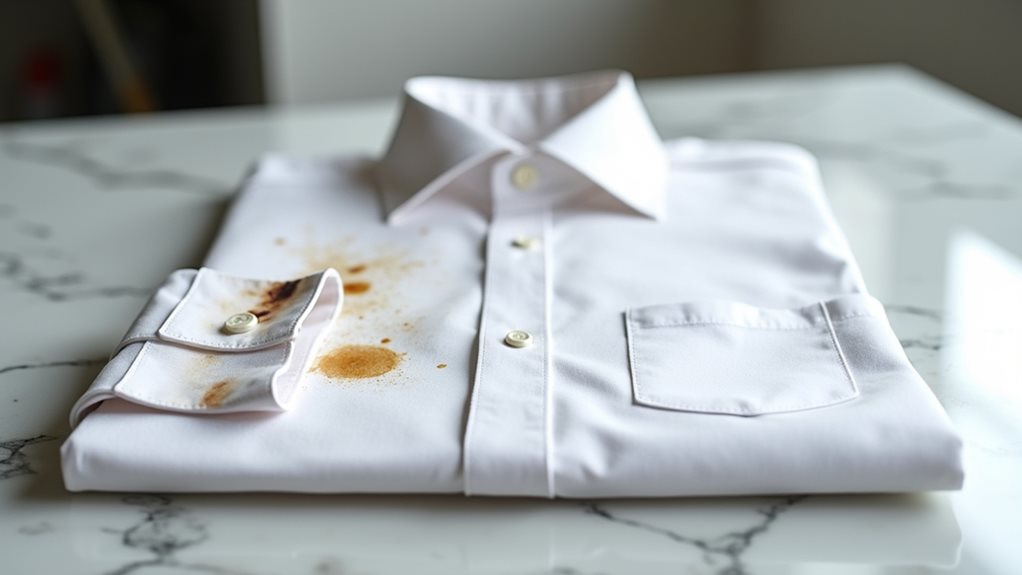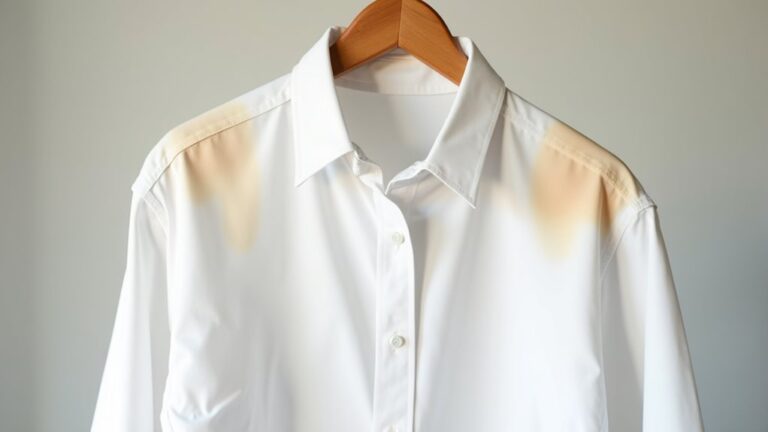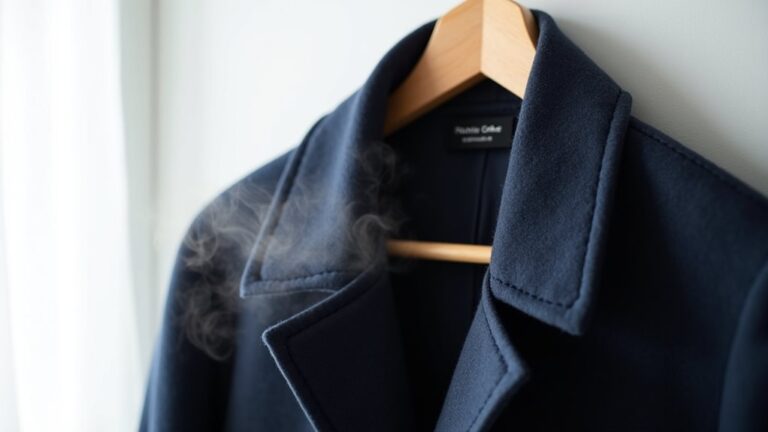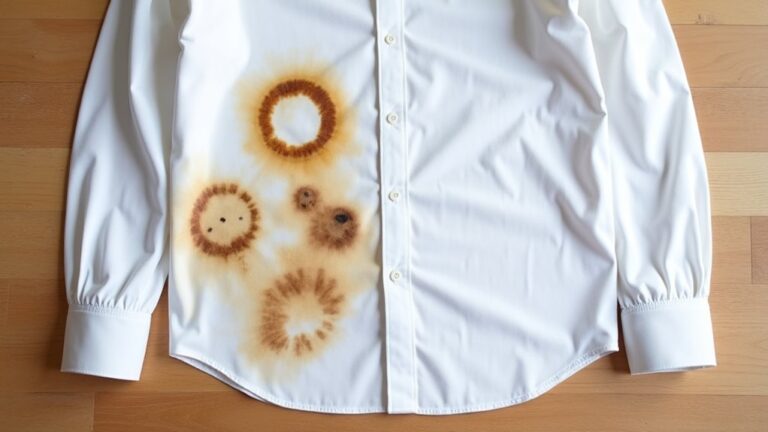Yes, dry cleaning effectively removes many stains that regular washing can’t handle, especially oil-based marks from cooking, makeup, and grease that dissolve beautifully in specialized solvents like perchloroethylene. You’ll find it works wonders on fresh stains, though age-set or protein-based stains might prove more stubborn and require enzyme treatments. While professional cleaners can’t guarantee 100% removal of every mark, they’ll often restore your garments far better than home methods, and understanding the specific challenges can help you set realistic expectations.
How Dry Cleaning Works on Different Types of Stains
When I first spilled red wine on my favorite silk blouse during a dinner party, I honestly thought it was destined for the donation pile – but that’s when I learned just how sophisticated dry cleaning chemistry really is.
Your professional dry cleaner uses different approaches for each stain type, which honestly amazed me once I understood the process.
Oil and grease stains dissolve beautifully in solvent-based cleaning agents, while protein-based stains from sweat or blood require special enzyme treatments that break down those stubborn molecules.
Tannin stains like my wine disaster get neutralized through targeted chemical treatments, and even tricky dye stains can be lifted without damaging delicate fabrics.
The key is trusting experts who know which methods will effectively remove stains.
However, dry cleaning does have limitations with certain water-based stains that don’t respond as well to chemical solvents compared to oil-based stains.
Oil-Based Stains That Dry Cleaning Removes Effectively
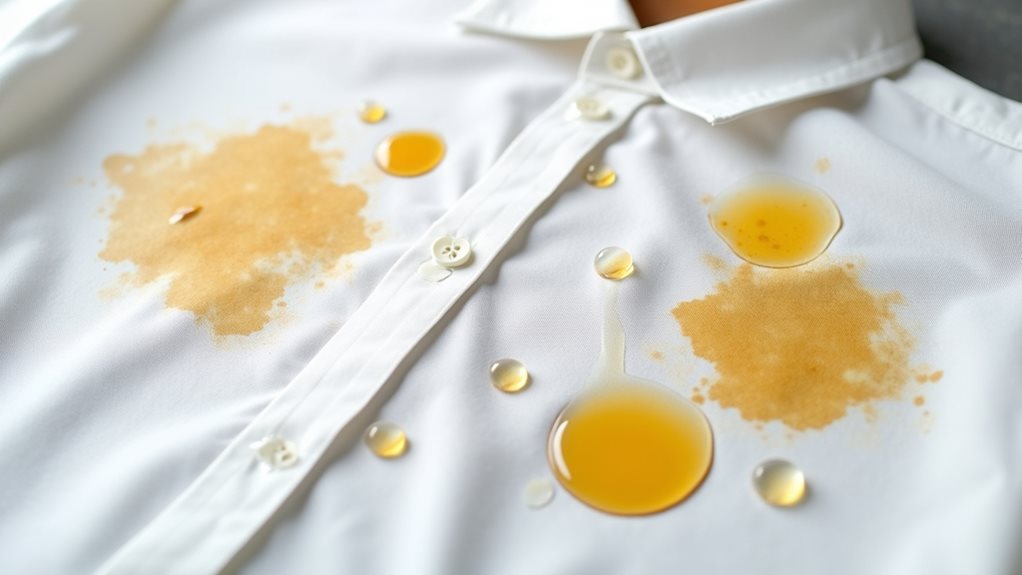
You’ve probably noticed how that splash of olive oil from last night’s pasta dinner seems to mock you from your favorite blouse, or how your toddler’s greasy fingerprints somehow found their way onto your work pants after a McDonald’s run.
Oil-based stains are sneaky little troublemakers that come from everywhere – cooking mishaps, makeup transfers, even that mysterious car grease that appears when you’re just trying to check your tire pressure.
The good news is that dry cleaning‘s specialized solvents work like tiny molecular magnets, dissolving these stubborn grease spots through a process that your home washing machine simply can’t replicate, which means you don’t have to say goodbye to that expensive silk scarf just yet.
Unlike water-based cleaning methods, dry cleaning uses chemical solvents that specifically target and break down oil-based stains that would otherwise resist traditional washing.
Common Oil Stain Sources
Oil stains have this sneaky way of appearing on our favorite clothes at the worst possible moments, and trust me, I’ve learned this lesson the hard way more times than I’d like to admit.
You’ll encounter these stubborn stains from cooking oils when you’re preparing dinner, motor oils during car maintenance, and even cosmetics like makeup foundations that somehow transfer onto your collar.
Salad dressings are notorious culprits during lunch meetings, while lotions and creams can create unexpected marks on delicate fabrics like silk blouses.
These oil-based enemies resist traditional cleaning methods because water simply can’t break down their lipid structure.
That’s where professional dry cleaning becomes your secret weapon, using specialized solvents designed to remove stains that would otherwise become permanent reminders of life’s messy moments.
The chemical solvents used in dry cleaning, such as perchloroethylene or newer eco-friendly alternatives, are specifically formulated to dissolve oils and grease in ways that water-based washing simply cannot achieve.
Solvent Dissolution Process
Although water-based detergents throw in the towel when faced with stubborn oil stains, dry cleaning solvents work like molecular magnets that actually attract and dissolve these greasy troublemakers at their core.
When you drop off that sauce-splattered silk blouse (we’ve all been there! 😅), professional cleaners use the solvent dissolution process to penetrate deep into fabric fibers, breaking down lipid bonds that make grease stains so stubborn.
Unlike traditional detergents that might set oil-based stains permanently, these specialized solvents lift away cooking oils, makeup, and motor grease without compromising garment integrity.
This targeted approach guarantees delicate fabrics receive gentle yet effective stain removal, preserving both the material’s structure and your wallet from costly replacements.
The most commonly used solvent, perchloroethylene, excels at dissolving oils and grease that water-based washing simply cannot tackle effectively.
Professional Treatment Advantages
When professional dry cleaners tackle oil-based stains, they’re wielding specialized weapons that your home washing machine simply can’t match, and trust me, the difference becomes crystal clear the moment you see your favorite shirt restored to its former glory.
Professional dry cleaning services offer advantages that go far beyond what you can achieve at home, especially when restoring clothing made from delicate fabrics that require gentle handling.
These experts use specialized solvents and cleaning agents designed to tackle tough stains at the molecular level, preserving fabric integrity while being incredibly effective at removing stubborn oil stains.
Their professional equipment and expertise mean they can safely treat materials that would be ruined by water-based washing methods.
The most commonly used solvent, perchloroethylene, dissolves grease and grime without damaging delicate fibers like wool and silk that water-based washing might shrink or harm.
Protein-Based Stains and Enzyme Treatment Solutions
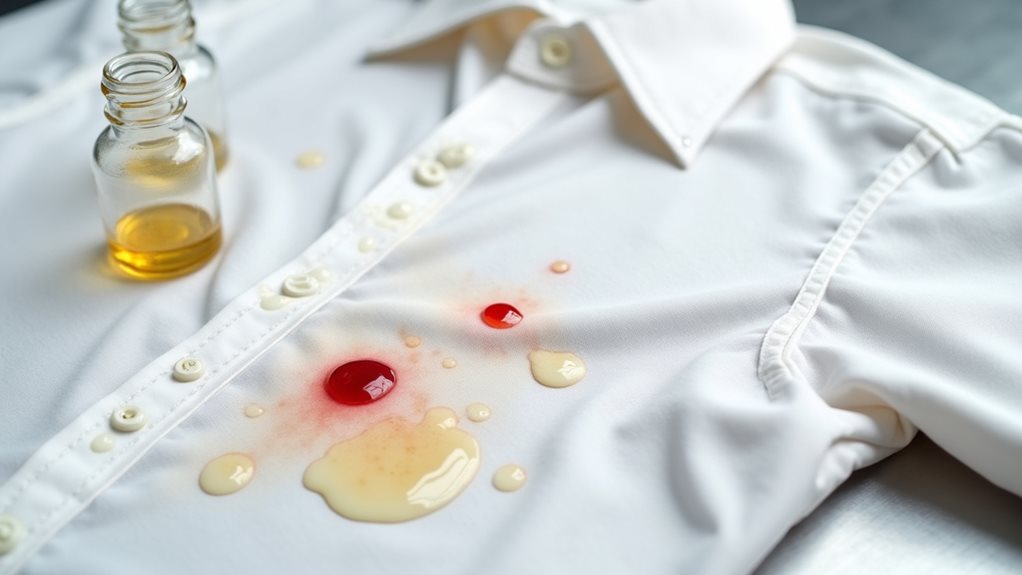
Since protein-based stains create some of the strongest bonds with fabric fibers, you’ll find that blood, sweat, and dairy spills become your garments’ most stubborn enemies.
I’ve watched countless people attempt traditional washing methods on protein stains, only to discover they’ve fundamentally “cooked” the proteins deeper into the fabric – think scrambled eggs! 😅
That’s where professional dry cleaning shines with specialized treatments using enzyme-based solutions that literally eat away at those protein bonds.
These powerful enzymes target specific molecular structures, achieving deep cleaning that your home washer simply can’t match, especially on delicate fabrics.
The secret lies in immediate treatment and effective removal techniques that preserve garment integrity while conquering even the most persistent stains.
Professional dry cleaning uses chemical solvents instead of water, making it particularly effective for protein-based stains that have bonded deeply with fabric fibers.
Tannin and Dye Stains: Professional vs. Home Treatment
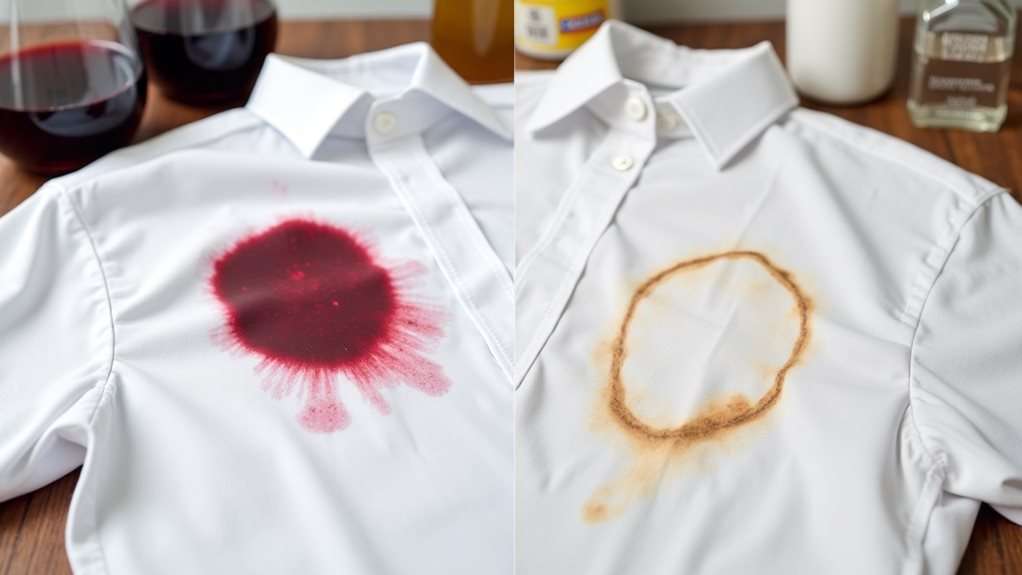
Moving beyond protein challenges, I’ve learned that tannin and dye stains present their own unique battlefield, requiring completely different strategies that separate the professionals from well-meaning home attempts.
When you’re dealing with tannin stains from red wine or coffee, professional dry cleaners wield specialized treatments that neutralize those stubborn compounds without compromising fabric integrity—something I’ve rarely achieved with home treatment methods.
Dye stains prove even trickier, demanding targeted solvents that preserve original colors while eliminating unwanted marks. While home remedies like lemon juice might seem promising, they can’t match the all-encompassing cleaning methods professionals use.
For dye transfer specifically, professional dry cleaners use specialized solvents that can break down and lift transferred dyes in ways that water-based washing simply cannot address.
Quick action remains essential for successful stain removal, but honestly, immediate professional intervention beats my kitchen-cabinet experiments every time!
Limitations of Dry Cleaning for Certain Stain Types
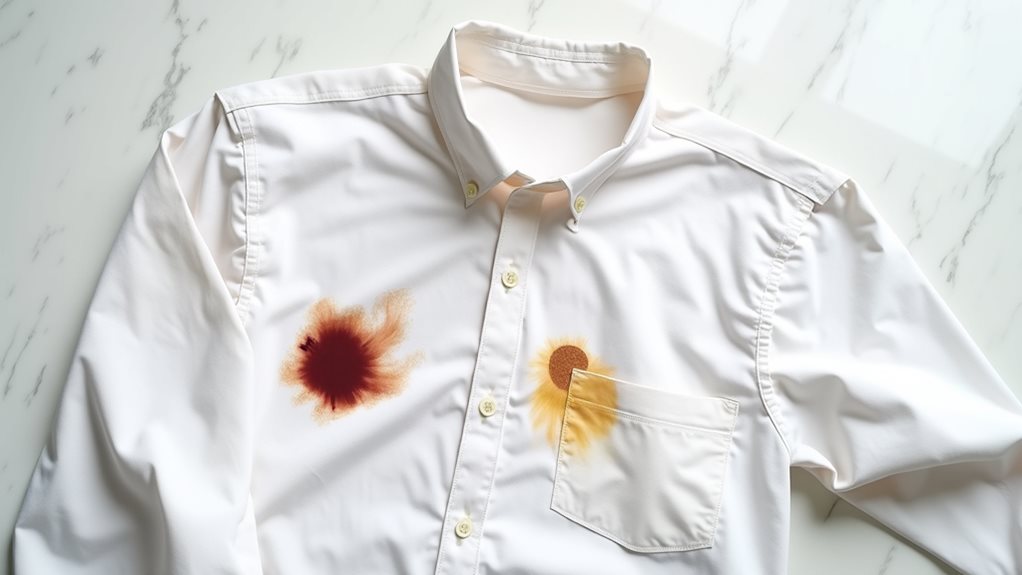
You might discover, like I did with my grandmother’s vintage silk blouse, that dry cleaning isn’t the miracle cure we’d hoped for when dealing with age-set stains that have practically become one with the fabric fibers.
Delicate materials like silk, wool, and leather can actually suffer more damage during aggressive stain removal attempts, leaving you with a cleaner garment that’s unfortunately weakened or discolored in unexpected ways.
Sometimes the most honest thing your dry cleaner can do is lighten that stubborn wine stain rather than promise complete removal, because pushing too hard might mean saying goodbye to your favorite piece altogether 😔.
While dry cleaning excels at removing oil-based and grease stains, challenging marks like ink or paint may prove much more difficult to eliminate completely, even with professional treatment.
Age-Set Permanent Stains
Why do some stains seem to laugh in the face of even the most skilled dry cleaner’s efforts? Age-set permanent stains have fundamentally moved in with your fabric, becoming deeply embedded roommates that refuse to leave.
When old stains sit for months or years, they bond with fabric material like stubborn barnacles on a ship’s hull. Professional dry cleaners often face disappointing success rates with these ancient marks, and honestly, I don’t blame them for being cautious.
Here’s what makes age-set stains so challenging:
- Stain type matters tremendously – protein-based stains become nearly impossible after heat-setting
- Specialized treatments may lighten but rarely guarantee complete removal
- Fabric damage risks often outweigh potential benefits
Unfortunately, those deeply embedded reminders can’t always be completely eliminated, no matter how much we wish otherwise. Blood stains that have been heat-set through previous washing attempts present particular challenges even for professional dry cleaning services.
Delicate Fabric Risks
When age-set stains meet delicate fabrics, you’re fundamentally asking your dry cleaner to perform surgery with oven mitts on.
Professional cleaners face an impossible balancing act—they can’t use aggressive solvents without risking fabric integrity, yet gentle treatments often leave stubborn stains laughing at their efforts.
Your silk blouse with intricate designs becomes a minefield where one wrong move could trigger color fading or distort those beautiful embellishments.
I’ve watched countless clients wrestle with this dilemma, torn between preserving their garment’s original condition and achieving spotless results.
The dry cleaning process simply wasn’t designed for miracles on delicate fabrics. Sometimes careful consideration means accepting partial stain removal over complete fabric destruction—a hard lesson I’ve learned 😔.
Additionally, traditional dry cleaning solvents like perchloroethylene (PERC) can leave chemical residues on delicate fabrics that require proper airing out before wearing, especially for items that come into close contact with your skin.
Incomplete Stain Lightening
Although professional dry cleaners work miracles on many stubborn stains, the harsh reality I’ve witnessed countless times is that some stains simply refuse to surrender completely, leaving you with lightened shadows of their former selves rather than pristine fabric.
This incomplete stain lightening happens more often than you’d think, especially with set-in stains that’ve bonded deeply with your garment’s fibers over months or years.
The age of stain dramatically affects the effectiveness of dry cleaning, and water-based stains can be particularly difficult to treat.
Professional cleaners often prioritize fabric integrity over aggressive removal techniques, resulting in partial stain removal rather than risking damage to delicate fabrics.
- Older stains become increasingly stubborn after multiple wash cycles
- Certain stain types resist traditional dry cleaning solvents completely
- Aggressive treatments might compromise your garment’s overall condition
When to Choose Professional Dry Cleaning Over Home Remedies
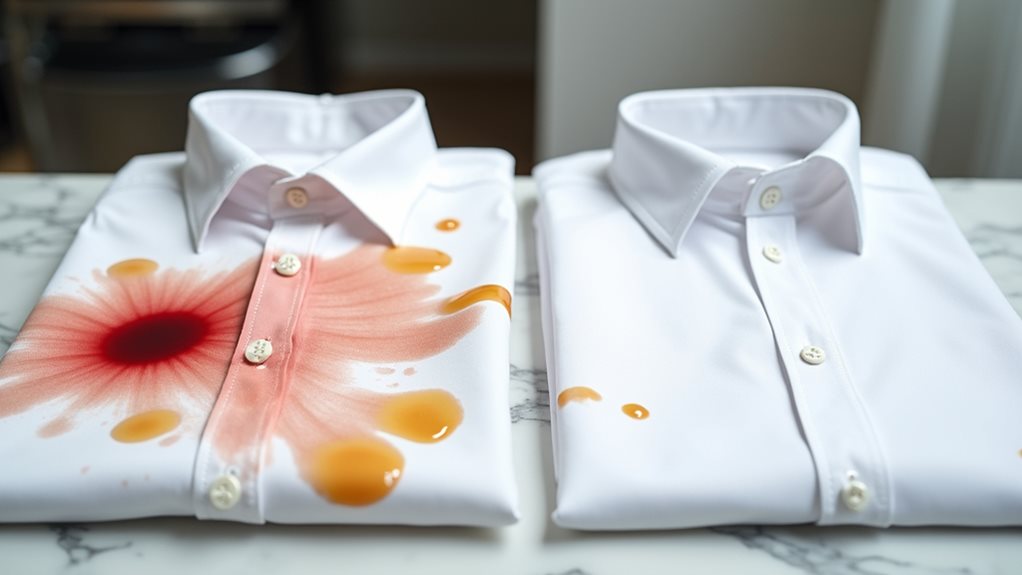
While you’re staring at that stubborn red wine stain on your favorite silk blouse, wondering if that Pinterest hack with salt and club soda will actually work, there’s a moment when you need to be honest with yourself about the limitations of DIY solutions.
Professional dry cleaning becomes vital when you’re dealing with delicate fabrics like silk, leather, or anything with beading – home remedies can actually damage these materials further.
Oil stains, grease marks, and protein-based spots laugh in the face of most household tricks, but chemical solvents used in dry cleaning remove stains effectively.
When immediate action is critical and you want to preserve fabric integrity, skip the kitchen cabinet experiments and head straight to the professionals.
Tips for Maximizing Stain Removal Success at Dry Cleaners
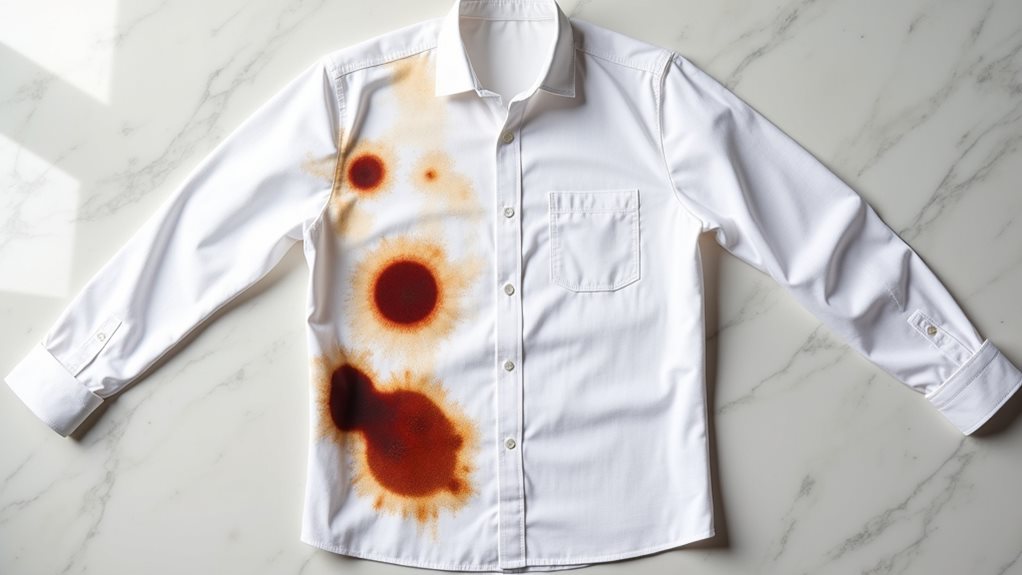
Success at the dry cleaner isn’t just about dropping off your stained garment and hoping for the best – it’s about becoming a strategic partner in the stain removal process.
When you walk in with that wine-stained blouse (we’ve all been there! 😅), your detailed communication becomes the difference between restoration and resignation.
- Act with immediate action – treat fresh stains quickly before bringing them in, as time makes even professional dry cleaners work harder against set-in damage.
- Provide thorough stain intel – describe exactly what caused the stain, when it happened, and any cleaning methods you’ve already attempted at home.
- Trust their expertise for delicate fabrics – resist trying stains at home remedies on silk or wool, as professional dry cleaners understand oil-based stains and preserving fabric integrity better than your Pinterest board.
This partnership approach transforms stain removal from guesswork into precision.

